- Home
- T.A. Barron
The Raging Fires
The Raging Fires Read online
The battle at the river . . .
The kreelix whirled around. Like an enormous bat, fangs bared, it swiped at me with its uninjured wing. I dodged—but a bony edge gouged my cheek. As I jabbed my blade at its chest, a river stone slipped under my foot, sending me careening backward. The sword flew out of my hand. Icy water rushed over me.
Before I could right myself, something heavy fell on top of me, pushing me deeper underwater. My ribs collapsed. I gagged, swallowing water, struggling to escape from the mass of fur that crushed my face and chest. My lungs screamed, my mind darkened.
All at once, a strong hand grabbed my arm and pulled me free. Air filled my lungs at last, though I coughed uncontrollably, spewing water like a fountain. Finally, the spasms quieted enough that I could make out Hallia, in her human form, dragging me from the river. She dropped me, sputtering, at the water’s edge, then left immediately.
After a moment, I raised myself on my elbow. Just downriver lay the half-submerged body of the kreelix, the broken shard of an antler lodged in its back. Then a realization colder than the frigid waves washed over me. On the other side of the kreelix lay another body, sprawled on the muddy bank. The body of Eremon.
PUFFIN BOOKS
Published by the Penguin Group
Penguin Young Readers Group, 345 Hudson Street, New York, New York 10014, U.S.A.
Penguin Group (Canada), 90 Eglinton Avenue East, Suite 700, Toronto, Ontario, Canada M4P 2Y3
(a division of Pearson Penguin Canada Inc.)
Penguin Books Ltd, 80 Strand, London WC2R 0RL, England
Penguin Ireland, 25 St Stephen’s Green, Dublin 2, Ireland (a division of Penguin Books Ltd)
Penguin Group (Australia), 250 Camberwell Road, Camberwell, Victoria 3124, Australia
(a division of Pearson Australia Group Pty Ltd)
Penguin Books India Pvt Ltd, 11 Community Centre, Panchsheel Park, New Delhi - 110 017, India
Penguin Group (NZ), 67 Apollo Drive, Rosedale, Auckland 0632, New Zealand
(a division of Pearson New Zealand Ltd.)
Penguin Books (South Africa) (Pty) Ltd, 24 Sturdee Avenue,
Rosebank, Johannesburg 2196, South Africa
Registered Offices: Penguin Books Ltd, 80 Strand, London WC2R 0RL, England
First published in the United States of America as The Fires of Merlin by Philomel Books,
a division of Penguin Young Readers Group, 1998
Paper-over-board edition, 2007
Published as The Raging Fires by Puffin Books, a division of Penguin Young Readers Group, 2011
Patricia Lee Gauch, editor
Text copyright © Thomas A. Barron, 1997
Map illustration copyright © Ian Schoenherr, 1996
All rights reserved
THE LIBRARY OF CONGRESS HAS CATALOGED THE PHILOMEL BOOKS EDITION AS FOLLOWS:
Barron, T. A. The fires of Merlin / T. A. Barron.
“Book three of ‘The lost years of Merlin.’”
p. cm.
Summary: Having voyaged to the Otherworld in his quest to find himself, the young wizard must face fire in many different forms and deal with the possibility of losing his own magical power.
ISBN : 0-399-23020-3 (hc)
1. Merlin (Legendary character) —Juvenile Fiction. [1. Merlin (legendary character)—Fiction.
2. Wizards—Fiction. 3. Fantasy.]
I. Title
PZ7.B27567Fi
1998 [Fic]—dc21 97-49561 CIP AC
Puffin Books ISBN 978-0-14-241921-2
Design by Gunta Alexander
Text set in Galliard
Printed in the United States of America
Except in the United States of America, this book is sold subject to the condition that it shall not, by way of trade or otherwise, be lent, re-sold, hired out , or otherwise circulated without the publisher’s prior consent in any form of binding or cover other than that in which it is published and without a similar condition including this condition being imposed on the subsequent purchaser.
The publisher does not have any control over and does not assume any responsibility for author or third-party Web sites or their content.
This book is dedicated to
Madeleine L’Engle
who has kindled the fires of inspiration in so many
with special appreciation to
Larkin
age two, whose own fires burn so bright
AUTHOR’S NOTE
Once again, this wizard is full of surprises.
As those who have read the first two volumes of The Lost Years of Merlin epic already know, Merlin first surprised me long ago. In his typically mysterious way, he pointed out that despite all the books, poems, and songs that have been written about him over the centuries, virtually nothing had been told about his youth. For there to be such an enormous gap in the lore about a character so rich, complex, and intriguing was strange indeed. So when Merlin invited me to serve as his scribe while he revealed at last the story of his lost years, I could not refuse.
Even so, I hesitated. I wondered whether it was really possible to add a new strand or two to the already wondrously woven tapestry of myth surrounding Merlin. And, even if it were possible, would the newly created threads feel integral to the rest of the weaving? Would their color, weight, and texture, while original, still feel part of the whole? Would they, in short, feel true?
Somehow, I needed to hear Merlin’s voice. Not the voice of the worldly enchanter, all-seeing and all-knowing, whom the world has come to celebrate. Far from it. Down inside of that legendary wizard, buried beneath centuries of struggles, triumphs, and tragedies, was another voice: the voice of a boy. Uncertain, insecure, and utterly human. Possessed with unusual gifts—and with a passion as great as his destiny.
In time, that voice at last came clear. Although it rang with vulnerability, it also carried deeper undertones, full of the mythic and spiritual richness of ancient Celtic lore. The voice sprang partly from those Celtic tales, partly from the mysterious hooting of the owl in the cottonwood tree outside my window—and partly from somewhere else. And it told me that, during those years of his youth, Merlin did not merely disappear from the world of story and song. Indeed, during those years, Merlin himself disappeared—from the world as we know it.
Who was Merlin, really? Where did he come from? What were his greatest passions, his highest hopes, his deepest fears? The answers to such questions lay hidden behind the shroud of his lost years.
To find the answers, Merlin must voyage to Fincayra, a mythic place known to the Celts as an island beneath the waves, a bridge between the Earth of human beings and the Otherworld of spiritual beings. Merlin’s mother, Elen, calls Fincayra an in between place. She observes that the swirling mist surrounding the island is neither quite water nor quite air. Rather, it is something akin to both and yet something else entirely. In the same sense, Fincayra is both mortal and immortal, dark and light, fragile and everlasting.
On the first page of Book One of The Lost Years of Merlin, a young boy washes ashore on an unknown coast. Almost drowned, he has no memory of his past—not his parents, not his home, not even his own name. Certainly he has no idea that he will one day become Merlin: the greatest wizard of all time, the mentor of King Arthur, the captivating figure who strides across fifteen hundred years of legend.
That book begins Merlin’s search for his true identity, and for the secret to his mysterious, often frightening, powers. To gain a little, he must lose a lot—more, even, than he comprehends. Yet somehow, in the end, he manages to unravel the riddle of the Dance of the Giants. As his journey continues in Book Two, he searches for the elixir that could save his mother’s life, following the winding path of the Seven Songs of Wizardry. Along the way, he must
surmount his share of obstacles, though one remains far more difficult than all the others. For he must somehow begin to see in an entirely new way, a way befitting a wizard: not with his eyes, but with his heart.
All this Merlin had revealed to us when the time came to begin Book Three—the final installment, I had thought, of the story. Then came the wizard’s latest surprise. He told me in no uncertain terms that the tale of his lost years could not possibly be told in just three volumes. When I reminded him that in the beginning he had promised me this would be a trilogy, itself at least a five-year project, he merely waved away my concerns. After all, he said with his unfathomable grin, what is a little extra time to someone who has already lived fifteen centuries? Let alone someone who has learned the art of living backward in time?
I could not object. This is, after all, Merlin’s story. And like Merlin himself, the other characters in the tale—Elen, Rhia, Cairpré, Shim, Trouble, Domnu, Stangmar, Bumbelwy, Hallia, Dagda, Rhita Gawr, and others yet to come—have taken on lives of their own. Thus, a projected trilogy has become a five-book epic.
In this volume, Merlin must confront fire in many different forms. He feels the fires of an ancient dragon, of a mountain of lava, and for the first time in his life, of certain passions of his own. He may find that fire, like himself, holds an array of opposites. It can consume and destroy, but it can also warm and revive.
In addition, Merlin must explore the nature of power. Like fire, power can be used wisely or abused terribly. Like fire, it can heal or devour. The young wizard may even need to lose his own magical power in order to discover where it truly resides. For the essence of magic, like the music of the instrument he has made with his own hands, may lie somewhere else than it appears.
The more I learn about this wizard, the less I really know. Even so, I continue to be struck by the remarkable metaphor of Merlin himself. Like the boy who washed ashore with no memory, no past, and no name, without any clue about his wondrous future, each of us begins anew at some point in life—or, indeed, at several points over the course of a lifetime.
And yet, much like that half-drowned boy, each of us harbors hidden gifts, hidden talents, hidden possibilities. Perhaps we also harbor a bit of magic, as well. Perhaps we might even discover a wizard somewhere inside of ourselves.
As in the prior volumes, I am grateful for the advice and support of several people, most especially my wife, Currie, and my editor, Patricia Lee Gauch. In addition, I would like to thank Jennifer Herron, for her bright spirit; Kathy Montgomery, for her contagious good humor; and Kylene Beers, for her unwavering faith. Without them, Merlin’s surprises would surely have overwhelmed me by now.
T. A. B.
Splendour of fire . . .
Swiftness of wind . . .
I arise today
Through the strength of heaven:
Light of sun,
Radiance of moon,
Splendour of fire,
Speed of lightning,
Swiftness of wind,
Depth of sea,
Stability of earth,
Firmness of rock.
—From a seventh-century hymn
by Saint Patrick called
The Cry of the Deer
PROLOGUE
The mists of memory gather, the more with each passing year. Yet one day remains as clear in my mind as this morning’s sunrise, although it happened those many centuries ago.
It was a day darkened by mists of its own, and by smoke thick and wrathful. While the fate of all Fincayra hung in the balance, no mortal creature suspected. For the mists of that day obscured everything but the fear, and the pain, and only the slightest hint of hope.
As still as a mountain for years beyond count, the massive gray boulder quite suddenly stirred.
It was not the fast-flowing water of the River Unceasing, slapping against the base of the boulder, that caused the change. Nor was it the sleek otter whose favorite pastime had long been sliding down the cleft between the boulder and the river’s muddy bank. Nor the family of speckled lizards who had lived for generations in the patch of moss on the boulder’s north side.
No, the stirring of the boulder on that day came from an entirely different source. One that, unlike the lizards, had never been seen at the spot, although it had in fact been present long before the first lizard ever arrived. For the source of the stirring came from deep within the boulder itself.
As mist gathered within the banks of the river, resting on the water like a thick white cloak, a faint scraping sound filled the air. A moment later, the boulder wobbled ever so slightly. With shreds of mist curling about its base, it suddenly pitched to one side. Hissing with alarm, three lizards leaped off and scurried away.
If the lizards had hoped to find a new home in the moss atop one of the other boulders, they were destined to be disappointed. For more scraping sounds joined with the constant splashing of the current. One by one, each of the nine boulders lining the river began to wobble, then rock vigorously, as if shaken by a tremor that only they could feel. One of them, partly submerged by the rushing river, started rolling toward a grove of hemlocks on the bank.
Near the top of the first boulder to come to life, a tiny crack appeared. Another crack split off, and then another. All at once, a jagged chip broke away, leaving a hole that glowed with a strange orange light. Slowly, tentatively, something started pushing its way out of the hole. It glistened darkly, even as it scraped against the surface.
It was a claw.
• • •
Far to the north, in the desolate ridges of the Lost Lands, a trail of smoke rose skyward, curling like a venomous snake. Nothing else moved on these slopes, not even an insect or a blade of grass trembling in the wind. These lands had been scorched by fire—so powerful that it had obliterated trees, evaporated rivers, and demolished even rocks, leaving behind nothing but charred ridges coated with ash. For these lands had long been the lair of a dragon.
Ages before, at the height of his wrath, the dragon had incinerated whole forests and swallowed entire villages. Valdearg—whose name, in Fincayra’s oldest tongue, meant Wings of Fire—was the last and most feared of a long line of emperor dragons. Much of Fincayra had been blackened by his fiery breath, and all its inhabitants lived in terror of his shadow. Finally, the powerful wizard Tuatha had managed to drive the dragon back to his lair. After a prolonged battle, Valdearg had at last succumbed to the wizard’s enchantment of sleep. He had remained in his flame-seared hollow, slumbering fitfully, ever since.
While many Fincayrans grumbled that Tuatha should have killed the dragon when he had the chance, others argued that the wizard must have spared him for a reason—though what that reason could possibly be no one knew. At least, in slumber, Wings of Fire could cause no more harm. Time passed, so much time that many people began to doubt that he would ever wake again. Some even questioned the old stories of his rampages. Others went further, wondering whether he had ever really existed, although very few indeed were willing to travel all the way to the Lost Lands to find out. Of those who did set out on the dangerous trek, very few ever returned.
Very little of what Tuatha had said at the conclusion of the Battle of Bright Flames had been understandable, for he spoke in riddles. And many of his words had been long forgotten. Still, a few bards kept alive what remained in the form of a poem called The Dragon’s Eye. Although the poem had many versions, each as obscure as the others, all agreed that on some dark day in the future, Valdearg would awaken once more.
Even now, these lands reeked of charcoal. Near the hollow, the air shimmered with the unremitting heat of the dragon’s breath. The low, roaring sound of his snoring echoed across the blackened ridges, while the dark column of smoke continued to pour from his nostrils, lifting slowly skyward.
• • •
The claw pushed higher, tapping the edge of the rocklike shell as cautiously as someone about to step on a frozen pond would tap the ice. Finally, the dagger-sharp tip of t
he claw dug into the surface, shooting cracks in all directions. A muffled sound, part screech and part grunt, came from deep inside. Then, all at once, the claw ripped away a large section of shell.
The enormous egg rocked again, rolling farther down the riverbank. As it splashed in the surging water, several more pieces of the shell dropped away. Although the morning sun had started to burn through the mist, its light did not diminish the orange glow radiating from the gaping hole.
More cracks snaked around the sides. The claw, curved like a huge hook, slashed at the edges of the hole, spraying fragments of shell in the river and on the muddy bank. With another grunt, the creature inside shoved the claw completely out of the hole, revealing a twisted, gangly arm covered with iridescent purple scales. Next came a hunched, bony shoulder, dripping with lavender-colored ooze. Hanging limp from the shoulder was a crumpled fold of leathery skin that might have been a wing.
Then, for whatever reason, the arm and shoulder fell still. For a long moment the egg neither rocked nor emitted any sound.
Suddenly the entire top half of the egg flew off, landing with a splash in the shallows. Rays of orange light shot into the shredding mist. Awkwardly, hesitantly, the scaly shoulder lifted, supporting a thin, purple neck flecked with scarlet spots. Hanging heavily from the neck, a head—twice as big as that of a full-grown horse—slowly lifted into the air. Above the massive jaw, studded with row upon row of gleaming teeth, a pair of immense nostrils twitched, sniffing the air for the first time.
From the creature’s two triangular eyes, the orange light poured like glowing lava. The eyes, blinking every few seconds, gazed through the mist at the other eggs that had also begun to crack open. Raising one of her claws, the creature tried to scratch the bright yellow bump that protruded from the middle of her forehead. But her aim was off and instead she poked the soft, crinkled skin of her nose.

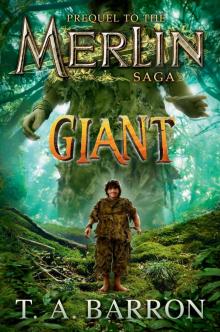 Giant
Giant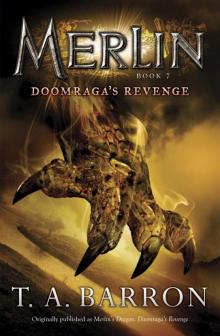 Doomraga's Revenge
Doomraga's Revenge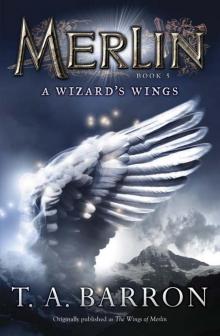 A Wizard's Wings
A Wizard's Wings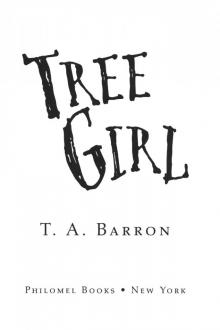 Tree Girl
Tree Girl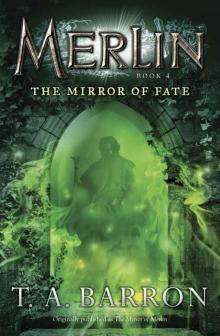 The Mirror of Fate
The Mirror of Fate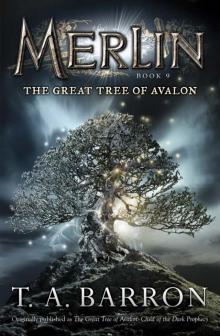 The Great Tree of Avalon
The Great Tree of Avalon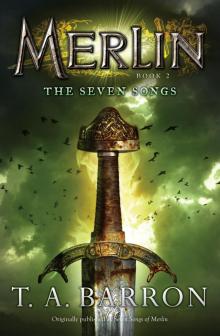 The Seven Songs
The Seven Songs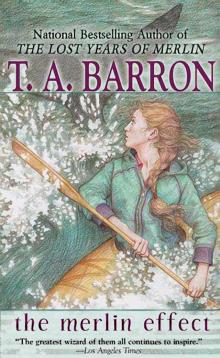 The Merlin Effect
The Merlin Effect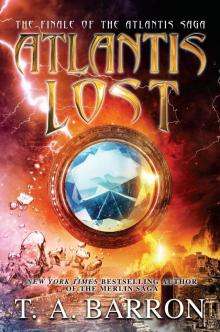 Atlantis Lost
Atlantis Lost Ultimate Magic
Ultimate Magic Atlantis in Peril
Atlantis in Peril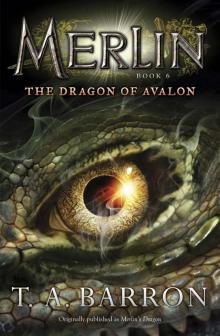 The Dragon of Avalon
The Dragon of Avalon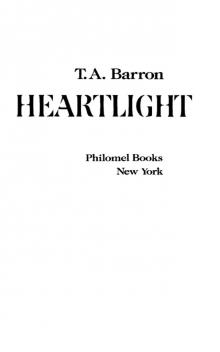 Heartlight
Heartlight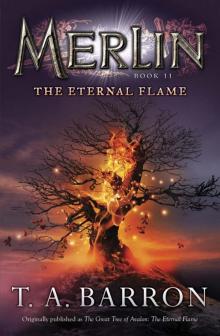 The Eternal Flame
The Eternal Flame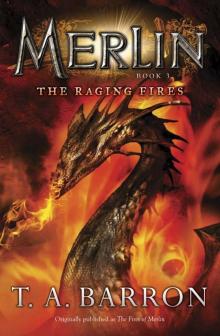 The Raging Fires
The Raging Fires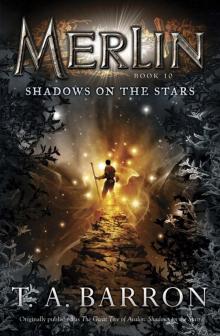 Shadows on the Stars
Shadows on the Stars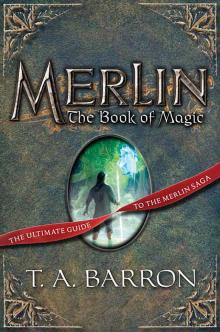 Merlin: The Book of Magic
Merlin: The Book of Magic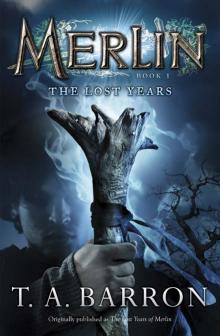 The Lost Years
The Lost Years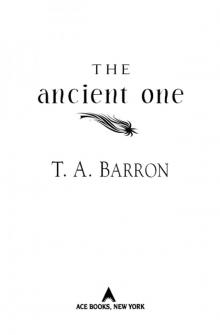 The Ancient One
The Ancient One Atlantis Rising
Atlantis Rising